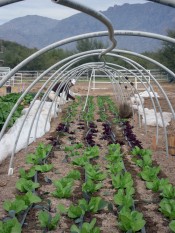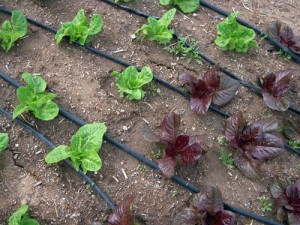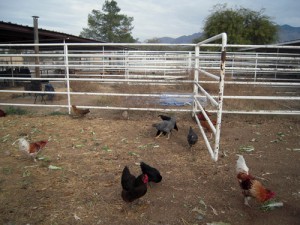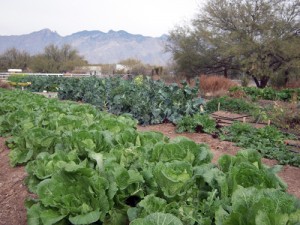Waldorf News
The Farm Individuality in a Desert City: River Road Gardens at the Tucson Waldorf School

By Rebecca Briggs
Nestled on a former horse ranch at the base of the Santa Catalina Mountains, immaculately maintained garden beds are islands of green in an otherwise arid landscape. Here farmers Jon McNamara and Emily Mabry are developing a unique biodynamic urban oasis on the grounds of the Tucson Waldorf School.
Sixty intensive vegetable beds, a chicken coop, compost trenches, native plantings, and a student-built earthen outdoor oven are new additions to a space that was a weedy horse pasture only two years ago. And according to Jon, this is just the beginning.
A Developing Vision
Jon and Emily are still working on the ultimate vision for the farm, which is in its second year. The land on which it operates—approximately 1.25 acres—is part of a larger parcel that was donated to the Tucson Waldorf School in 2008. In response to this generous gift, the Waldorf community undertook a visioning process for what the property should represent. The proposal to start a community supported agriculture (CSA) venture on the property was well received, and Jon and Emily entered into a five-year lease agreement with the school.
Their hope is to create a scale-model closed system on the property that can be used as a biodynamic educational tool for the school and broader Tucson community. They are slowly increasing the amount of bed space, but they are also hoping to bring in a cow or two, build a greenhouse, and establish a mini-orchard.
In addition, they are looking at ways to expand their business. Given their warm southwestern climate, River Road Gardens operates year-round. Their main focus is the CSA, which they hope to grow to 100 shares; it started with 35 and will have 65 shares this year. They also operate a farm stand on Saturdays and are pursuing relationships with local restaurants. But Jon maintains that, before expanding, it is important to establish strong relationships and make sure the farm can meet those needs first.
River Road Gardens was established as an LLC company. Although it is legally independent of the Waldorf school, the farmers run their ideas by the school to make sure there is no conflict. They have done well financially so far, but Jon notes that it is a constant challenge not to fall into a purely black-and-white economic way of thinking. River Road Gardens’ ideals extend well beyond simply generating a profit.
The farm has already grown beyond the literal bounds of the 1.25 acres. Jon reports that they are also leasing a neighboring property for more eventual beds from Vision Quest, a group home for teenage boys, which is supportive of the work happening at River Road Gardens. Through this collaboration, Jon hopes to expand the vegetable production and compost operations and increase the chicken production. He would like to see enough eggs produced to supply the CSA.
Currently, though, there are only enough eggs for the eight WWOOF workers on the farm. Employed through the organization Willing Workers on Organic Farms, the WWOOFers trade their labor for room and board, which means that River Road Gardens must lease land for housing.
The garden is meant to fit well within the school’s larger vision of building a campus. While only grades four through eight are located on the property now, the hope is to develop the buildings necessary to bring the other grades out. But in the meantime, the third grade comes to the property once a week as part of the Waldorf curriculum.
Emily is a passionate educator, working with the school to bring the children into the garden to learn. In addition to the Waldorf School students, the farm brings in children with neurological and behavioral issues for occupational therapy. Emily notes that children need to find that connection to the natural world for themselves. Profound changes can be seen, she says, when we can allow ourselves just to be, when we give ourselves over to the plant world. Watching Emily’s careful, focused weeding, one can begin to see this connection.
 Biodynamics in the Desert
Biodynamics in the Desert
Jon waxes philosophical about what it means to be a biodynamic farm in a city in the Sonoran desert environment. Compromises may be necessary, he recognizes, but if so, he wants to make them “in a conscious way.” For example, the compost piles are based on horse, not cow, manure, as horse ranches are plentiful in this area. The manure currently comes from off-site, although this will change at least partially if Jon realizes his hope of bringing in cows. Although a compromise, Jon believes this achieves biodynamic goals, as it uses the manure of animals common to the area, makes use of what would otherwise be waste materials, and establishes bonds with the surrounding community.
In the same way, River Road Gardens made the conscious decision to use municipal reclaimed water. The use of reclaimed water can be controversial, but they felt that it was the most ecologically responsible course of action for their arid environment. Although there is a well on the property, Jon believes it is better to reclaim, if possible, than to tap into the desert’s limited water table. And so they must put extra effort into biodynamic soil remediation to account for the increased salts and higher mineral content of the water. They make every attempt to use as little water as possible. Each bed is irrigated with drip hoses, which is economically and practically possible given the farm’s small scale.
They continue to experiment to find the best way to farm biodynamically in the desert. Compost production is a particular dilemma, as they ran into problems with inconsistent moisture when attempting to do it with windrows. They are now working with the trench method, which seems to have alleviated the moisture problems, but they are still dealing with issues of getting a consistent size for the materials that go in the pile.
Hoping to spread understanding of biodynamics out to the wider community, Jon believes it will be important to bury horns on the property this coming fall. They also grow all the biodynamic compost preparation herbs on site except for equisetum. By applying biodynamic practices in such a visible location, with children and parents wandering through as they wish, and by building ties to the community beyond the Waldorf school—such as local horse ranchers, beekeepers, and the non-profit organization Native Seeds \ SEARCH—they hope to create a biodynamic model that people can see and interact with.
 Agriculture and Urbanism
Agriculture and Urbanism
Farming in an urban area poses unique problems, such as visual and noise pollution. River Road Gardens sits, not surprisingly, right on River Road, a relatively well-used artery on the north side of the city. Trucks pass by on a regular basis, engines humming and tailpipes spewing. Though they are working to establish native plantings as a buffer at the border of the property and the road, their location in a historic district means they must abide by certain stipulations and cannot plant anything that obscures the pastoral view from the road. While Emily notes that not everyone is bothered by the noise, or that some become accustomed to it, she continues to find it hard to ignore.
River Road Gardens is fortunate in several ways, however. It sits just beyond the city boundary, allowing it to operate outside the purview of city zoning laws. And it also sits in a floodplain, which means it has some of the best, most fertile soil in the area.
Although Jon and Emily apologized that there was not much growing when I visited in late December, a fact compounded by a recent hard freeze, I could not help but note that every bed seemed to be filled with something – from tiny lettuce starts to mature cabbages. It sure seemed lush to me. They did concede, however, a sense of relief in the winter season, as the profusion of sprawling warm-season growth can seem to take over. Though it seemed restrained to them, I was struck by the garden’s contrast not only to the desert’s stark landscape, but also to the surrounding urban drabness. It seemed a true oasis.
Setting an Example
Perhaps even more amazing than the lush green beds, however, is the fact that this is Jon and Emily’s first farming experience. Jon was a residential landscaper, and so had created some small-scale residential food gardens and had basic horticultural knowledge, but they had never attempted production agriculture—much less biodynamic agriculture. In fact, although both Emily and Jon have been familiar with biodynamic agriculture through their involvement with the Waldorf community, they took a big leap by putting it into practice at River Road Gardens. Given the farm’s location on Waldorf school property, they felt it especially important to understand and implement biodynamic methods.
When people ask how to get started in biodynamics, it can seem disingenuous and simplistic to say, “Just do it!” The financial realities of farming can be intimidating; trying to farm according to the biodynamic ideal can seem even more so.
But Jon and Emily just did it. And look what they have started.
 To learn more, visit www.riverroadgardens.com.
To learn more, visit www.riverroadgardens.com.
This article was originally published in the Spring 2011 issue of Biodynamics, the quarterly membership journal of the Biodynamic Farming and Gardening Association, www.biodynamics.com
Rebecca Briggs is Communications Coordinator and Editor of the Biodynamics journal for the Biodynamic Farming and Gardening Association.
 Immersive Academics and Arts
Immersive Academics and Arts Summer Programs - Culminating Class Trips
Summer Programs - Culminating Class Trips Bay Area Teacher Training
Bay Area Teacher Training The Journey is Everything
The Journey is Everything Quality Education in the Heartland
Quality Education in the Heartland Train to Teach in Seattle
Train to Teach in Seattle Transforming Voices Worldwide
Transforming Voices Worldwide Waldorf Stories for Everyone
Waldorf Stories for Everyone Middle School Science With Roberto Trostli
Middle School Science With Roberto Trostli Flexible preparation for your new grade
Flexible preparation for your new grade Preparing Teachers for 2024-25 Grades 1-8
Preparing Teachers for 2024-25 Grades 1-8 Jamie York Books, Resources, Workshops
Jamie York Books, Resources, Workshops Everything a Teacher Needs
Everything a Teacher Needs Training in Traumatology & Artistic Therapies
Training in Traumatology & Artistic Therapies ~ Ensoul Your World With Color ~
~ Ensoul Your World With Color ~ Great books for Waldorf Teachers & Families
Great books for Waldorf Teachers & Families Roadmap to Literacy Books & Courses
Roadmap to Literacy Books & Courses Caring for All Stages of Life
Caring for All Stages of Life Space speaks. Its language is movement.
Space speaks. Its language is movement. Association for a Healing Education
Association for a Healing Education Waldorf-inspired Homeschool Curriculum
Waldorf-inspired Homeschool Curriculum Grade-specific web courses for teachers
Grade-specific web courses for teachers Full-Time Teacher Education
Full-Time Teacher Education Bringing Love to Learning for a Lifetime
Bringing Love to Learning for a Lifetime Waldorf Training in Australia
Waldorf Training in Australia Grade Level Training in Southern California
Grade Level Training in Southern California RSS Feeds
RSS Feeds